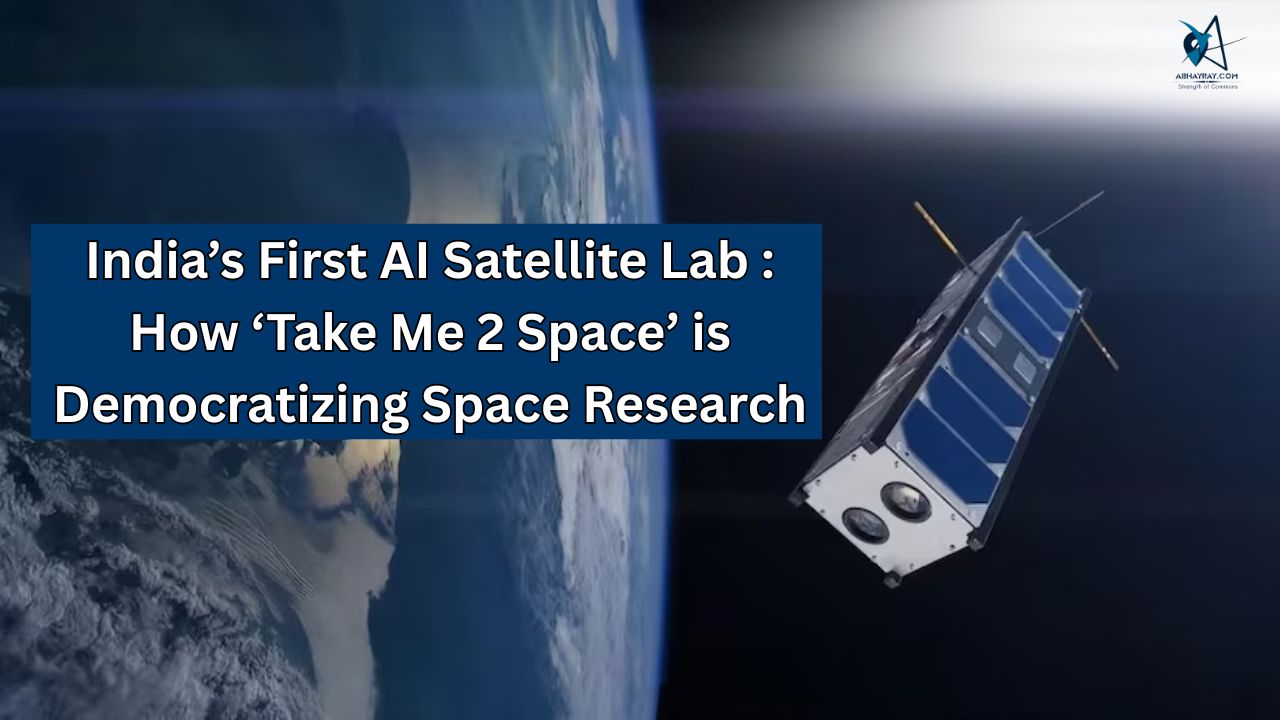Introduction
A Hyderabad-based tech startup “Take Me 2 Space” launched an ambitious project — AI-driven satellite laboratories that can be operated remotely from anywhere. This is the first time that such a project has been launched in India. The project makes space sciences more accessible and students across the country can get a chance to operate satellites remotely. This can also gear up the chances of Indian dominance in space. This barrier-breaking initiative in space research is seeking to put India on the front line with countries like the USA and China. So far, in India, only government agencies and top research institutes dominate the field. By offering students, researchers, and even businesses access to real-time satellite operations, Take Me 2 Space hopes to level the playing field.
The CEO and Founder of “Take Me 2 Space” – Ronak Kumar Samantray
Ronak Kumar Samantray, the founder and CEO of TakeMe2Space, has a background in computer science engineering, having completed his degree in 2008. After his education, he joined Microsoft, marking the beginning of his professional journey in the technology sector. His passion for space technology led him to establish TakeMe2Space, a Hyderabad-based startup focused on democratizing space access. The company aims to make space more accessible by providing real-time satellite access to students, researchers, and businesses. In December 2024, TakeMe2Space launched India’s first AI lab in space, demonstrating real-time data processing in orbit. Through his entrepreneurial endeavors, Samantray is working to revolutionize space research and make it more affordable and accessible to a broader audience.Ronak is a innovative thinker, hard worker and extremely passionate about the technology. He was very committed with his work and remain extremely focussed.
Making Real-Time Satellite Access Available to All with ISRO Partnership
Ronak Kumar Samantray ,The founder of Take Me 2 space focused on the lab’s remote work and emphasised that, regardless of location, the lab would allow everyone to conduct experiments smoothly. “Our goal is to ensure that everybody’s ideas can be taken to space,” Samantray told AIM in an exclusive interview. “You don’t have to be in NASA, ISRO, or an IIT to run an experiment in space. Sitting in Kerala, Delhi, or even Antarctica, you should be able to operate a satellite.”
In contrast to conventional models where satellite access is limited to governments, defense organizations, or prestigious research institutions, TakeMe2Space aims to make space more accessible by providing real-time satellite access to students, researchers, and businesses. The company recently conducted a technology demonstration mission with ISRO, proving the viability of its approach. Now, the next step is launching two fully operational satellites this year, with a long-term ambition to build the future of computing in orbit.
Bringing Space Closer : Hands-On Experience for the Next Generation
TakeMe2Space aims to bridge this gap by offering an AI-powered satellite lab. Schools and universities can subscribe, allowing students to log in remotely, upload code in Python or C++, and interact with a real satellite. “Just like how schools have computer labs, electronics labs, and robotics labs, we believe there should be a satellite lab,” said Samantray. “Our satellites will be openly accessible for students to run their personal experiments.” So far, the education sector has shown interest, but surprisingly, most early adopters are not universities. Out of 20 customers who have signed up, only four are from the education sector, while the remaining 16 are from GIS (geographic information systems) and data analytics companies. From a business point of view, the company provides “for ₹ 20,000 in the pricing, 90 minutes of the satellite time in orbit.”
The Working of AI in TakeMe2Space
The integration of AI in TakeMe2Space’s approach sets it apart from traditional satellite models. While conventional satellites capture raw data that is processed on Earth, AI-powered satellites can process images while in orbit, determining which data to collect and transmit.One experiment carried out by the University of Southampton in TakeMe2Space’s AI lab used a low-power AI algorithm to minimize motion blur in satellite images. “Satellites travel at 7 km per second, making it difficult to capture sharp images,” explained Samantray. “Rather than relying on traditional pointing and staring methods, AI can eliminate motion blur in real-time.”
Robust Privacy and Data Security Measures
As TakeMe2Space expands satellite access to a wider audience, concerns around data security and ethical use have emerged.Allowing individuals and businesses to control satellites in real time raises questions about privacy, misuse, and cybersecurity risks. Founder Ronak Kumar Samantray acknowledged these issues and explained the measures the company has put in place to address them.
“We must stay two steps ahead in security,” he said, emphasizing that the system is designed to prevent harmful actions proactively. To ensure the safety of the satellites, TakeMe2Space has avoided equipping them with propulsion systems, eliminating the risk of hijacking or redirection. Furthermore, the company has restricted satellite image resolution to a maximum of 5 meters per pixel, ensuring that privacy is protected.
Regarding data security, TakeMe2Space adheres to strict encryption protocols, and customers retain ownership of their generated data. The company does not store or claim rights to it, positioning itself as an infrastructure provider similar to AWS.
Building The Future of Space Computing in India
At present, the Indian space economy is valued at approximately USD 8.4 billion, constituting a 2% share of the global space market. The government envisions scaling the space economy to USD 44 billion by 2033, including US $11 billion in exports amounting to 7-8% of the global share.The country currently operates 56 active space assets, including 19 communication satellites, nine navigation satellites, four scientific satellites, and 24 earth observation satellites, as per the economic survey 2024-25. TakeMe2Space believes that accessing space should be as simple as logging into a cloud computing service.
The project of Take Me 2 Space is planning to set up data centres in orbit as well, which will be powered by AI and other computing resources that are located in space rather than on earth. The focus of the labs is not only restricted to please government initiatives but will also cater to private organisations. After a demonstration mission with ISRO, the startup plans to launch two operational satellites. Looking ahead, Samantray hopes that successful implementation will make space research more accessible globally, opening up new possibilities for education and innovation.
Conclusion
TakeMe2Space is pioneering a transformative shift in India’s space ecosystem by making satellite technology accessible to students, researchers, and private organizations. With AI-powered, remotely operated satellite labs, the startup is not only breaking down long-standing barriers in space research but also positioning India as a global leader in democratized space innovation. Through strategic partnerships with ISRO, robust data security measures, and a focus on real-time AI processing in orbit, TakeMe2Space is setting a new standard for the future of space education and computing. As the company moves toward launching operational satellites and space-based data centers, it is paving the way for a more inclusive, innovative, and connected space economy.
GMICapitals.com RaysVeda.com GetMyStartup.com LawCanal.com GetMyIndia.com ZinCob.com Angeltors.com

